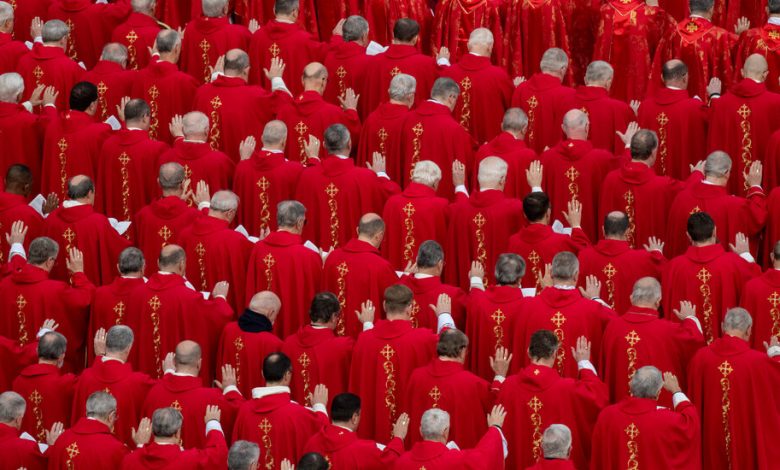The War Between the Catholic Cardinals

The death of the pope emeritus, Benedict XVI, was succeeded by a small literary outpouring, a rush of publications that were interpreted as salvos in the Catholic Church’s civil war. The list includes a memoir by Benedict’s longtime secretary that mentioned the former pontiff’s disappointment at his successor’s restriction of the Latin Mass, a posthumous essay collection by Benedict himself that’s being mined for controversial quotes, and an Associated Press interview with Pope Francis that made news for its call to decriminalize homosexuality around the world.
Amid all these words, two interventions deserve particular attention. One isn’t exactly new, but the revelation of its author elevates its importance: It’s a memorandum, intended for the cardinals who will elect Francis’s successor, that first circulated in 2022 and has now been revealed by the Vatican journalist Sandro Magister to be the work of Cardinal George Pell of Australia, a leading conservative churchman who passed away just after Benedict.
Beginning with a bald declaration that the Francis pontificate has been a “catastrophe,” the memorandum depicts a church falling into theological confusion, losing ground to evangelicalism and Pentecostalism as well as secularism, and weakened by financial losses, corruption and lawless papal governance. (On the climate within the Vatican, Pell writes: “Phone tapping is regularly practised. I am not sure how often it is authorized.”)
The other is a long essay by Pell’s fellow cardinal, Robert McElroy of San Diego, that ran this week in America, the Jesuit magazine. It shares with Pell’s memo a premise that the church faces debilitating internal divisions, but it argues that division should be resolved through the completion of the revolution sought by the church’s liberals. In particular, McElroy urges the church to shelve any meaningful judgment on sexual relationships and to open communion to “all of the baptized,” presumably including Protestants. Only this kind of radical inclusion, he suggests, has “any hope of attracting the next generation to life in the church.”
That the contending factions within Catholicism hold very different views is not a revelation, but it’s still striking to have them stated so frankly by prominent cardinals: Pell’s direct criticism of the Francis papacy and McElroy’s straightforwardness about his liberal goals makes plain what is often rhetorically obscured.
It’s not just their substance but their style that’s illuminating. In Pell’s terse, brusque list you can see a condensation of conservative alarm over the condition of the church. In McElroy’s more expansive calls for “dialogue” and “discernment,” you can see the confidence of a progressive Catholicism that assumes that any dialogue can lead in only one direction.
And in the distance between their presuppositions, which start with differing sociological analyses of why the church is struggling and end with a vast doctrinal gulf, you can feel the shadow of schism hanging above the 21st-century church. McElroy is not a radical theologian; Pell was not a marginal reactionary. These are mainstream figures laboring at the heart of the Catholic hierarchy, and yet the gap between their worldviews seems like it could place them in entirely different branches of the Christian faith.
For all their undeniable conservatism, a consistent goal for Benedict as well as John Paul II was some kind of synthesis for the modern church, in which the changes ushered in by Vatican II could be integrated with the traditional commitments of Catholicism. Their era has now ended, but if the church is to hold its current factions together for the long run, a synthesis is still necessary; mere coexistence is probably not sustainable. (The current attempt by Francis-aligned prelates to basically crush the Latin Mass shows how quickly it gives way.) Some kind of stronger bridge would have to exist between the McElroy and Pell worldviews for their successors to still share a church in 2123.
Is that imaginable? As someone who basically agrees with Pell’s diagnosis, I can read McElroy and find points of reasonable discussion, particularly where he talks about the role of Catholic women in the governance of the church. In theory one can imagine a Catholicism with more nuns and laywomen in important offices that retains its core doctrinal commitments, just as — to jump off from the pope’s recent interview — one can imagine a church vigorously opposed to unjust discrimination or state violence against gay people that also still holds to the rule of chastity and the centrality of sacramental marriage.
But syntheses can’t just be drawn up on paper, they have to live in the hearts of actual believers. And right now the tendency is toward irreconcilable differences, toward a view of Catholicism’s future, on both sides of its divides, where the current argument can only be resolved only with four simple words: We win, they lose.
The Times is committed to publishing a diversity of letters to the editor. We’d like to hear what you think about this or any of our articles. Here are some tips. And here’s our email: [email protected].
Follow The New York Times Opinion section on Facebook, Twitter (@NYTOpinion) and Instagram.
